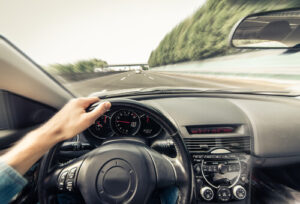Driving is one of those things you’re either passionate about or indifferent to. There are drivers out there who see driving as nothing more than the necessary evil they have to deal with to reach a place they need to be. On the other hand, some drivers love driving and are looking for reasons to take their Audi or BMW out for a spin. No matter which of these two groups you belong to, you’ll want to know how to use cruise control in your car.
What is Cruise Control?
Driving can be fun for a while. It’s one thing to enjoy an awesome track day or even a commute to work through winding roads if you have any near you. However, everyone can agree that there is absolutely nothing interesting or exciting about driving down I-95 through several states. Not only is it boring, but it can also be fatiguing.
Modern cars are full of all kinds of bells and whistles that make us safer highway drivers. However, before any of those things became a part of standard equipment, all we had is simple cruise control.
Cruise control is a system that automatically maintains speed, allowing you to take your foot off the gas. Most cars have control commands on the steering wheel or right behind it. You can use these controls to engage, disengage the control, increase and decrease speed. But, there’s more than one type of cruise control.

How Does Cruise Control Work?
With the advent of ECUs, or Engine Control Units, all cars became open to various technological advancements. One of them is the cruise control system. This feature takes the speed measurements from different parts of the engine to assess how fast the vehicle is traveling at any given moment.
With that data and the desired speed you give it, the system will take over and automatically adjust speed to match your input.
Adaptive Cruise Control
Cruise control, much like most other automotive features, has evolved over the years. The stuff they install in modern cars is a whole different beast. They utilize a built-in radar system that continuously monitors traffic in front and sometimes even around the vehicle.
Once you set your speed, the vehicle will maintain it unless it notices a car in your lane. Then it will keep a set distance by braking or slowing down to match the speed of the front vehicle. Some brands also utilize lane assist technology with their adaptive cruise control. The most advanced is found in modern electric cars and is bordering an actual autopilot.

Cruise Control Controls
Although different manufacturers do things slightly differently, you’ll find that almost every system out there works more or less the same. There are five main controls you’ll run into:
- Activation Button – The cruise control activation button is often labeled ‘CRUISE’ or features a little icon that depicts an odometer with an arrow pointing to it. This is your ON/OFF button.
- SET +/- Buttons – Next, we have two buttons that serve a dual purpose. You’ll often see SET+ and SET- buttons stacked one on top of the other. These are used to set cruising speed but also increase or decrease cruising speed.
- Cancel Button – Then there’s the Cancel button, which effectively disengages the cruise.
- Resume Button – The resume button is used to resume cruise control.
Keep in mind that some cars may have all of these or just some.
How to Activate Cruise Control?
To activate, you first need to get up to the desired speed. One thing to keep in mind is the difference between using cruise control in manual transmission cars and automatic transmission cars.
With manuals, you’ll want to get into the correct gear and then activate cruise control. The correct equipment is the one that gives you the best fuel efficiency (you don’t want to drive 70mph in 3rd gear on the interstate), but also the most flexibility if you decide to increase/decrease speed while in CC mode.
On the other hand, if you drive an automatic, the chances are that your cruise control will shift through gears for you as you increase or decrease speed.
Anyway, as you’re coming up to speed, press the Cruise Control button to activate the system. Once you reach the desired speed, press either of the SET buttons. It shouldn’t matter if it’s + or – button as both should set whatever speed you’re at as the vehicle’s cruising speed.
Tips on Using Cruise Control
Just because you can use the option doesn’t mean it should always be on. Here are a few tips on using this feature to your advantage without putting yourself at risk.
For one, we recommend that you never use it in the city, in heavy traffic, or anywhere where you’re expected to bring your vehicle to a stop suddenly. It was designed to be used on open highways and other roads where you won’t change your speed too often.
Most systems won’t allow you to engage the cruise as long as your vehicle goes under 25-30 mph or thereabout. Additionally, if you’re driving down the interstate or a highway, but you’re about to pass through a low-speed area, you can cancel it and then resume it after you’ve reached open roads again. The system should remember your last set speed and go back to it as soon as you press the resume button.
Is Cruise Control Good for Gas Mileage?
Absolutely! Driving at a set speed is always going to use less fuel than continually braking and accelerating. More importantly, driving at a set speed reduces the wear on the engine, thus prolonging its overall lifespan. The use of cruise control is recommended when you’re covering long distances in a single take. Your car and your wallet will thank you for it.



